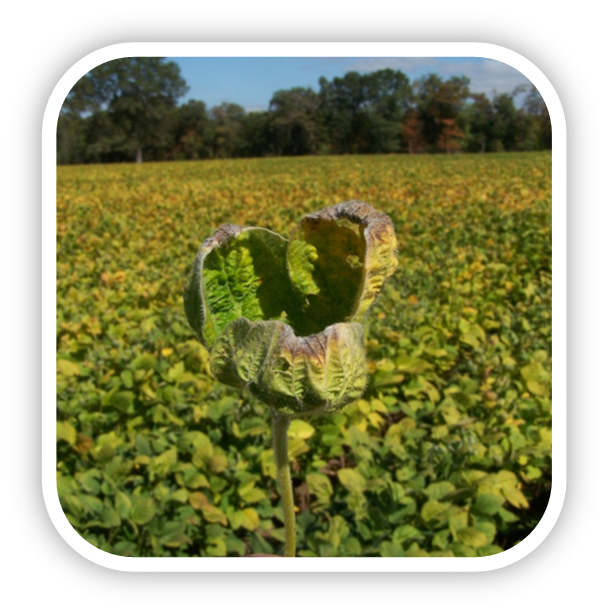By Matt Morris, Agriculture Extension Educator
University of Maryland Extension, Frederick County
Dicamba tolerant soybeans, marketed under the trade name Roundup Ready 2 Xtend soybeans, are again available to Maryland growers for the 2018 growing season. This line of soybeans will combine previous Roundup Ready technology with tolerance to the herbicide dicamba.
While this new dicamba tolerance may be useful in combating certain tough-to-control weeds, including marestail and palmer amaranth, use caution when applying dicamba. Applications of dicamba may cause problems due to the sensitivity of certain crops to the herbicide. Exposure can occur due to drift, volatility, or a non-target application.
Below are some recommendations to consider when using new dicamba-tolerant technologies.
- Dicamba type:
The only dicamba products that will be approved for in-crop use with Xtend soybeans will be XtendiMax from Monsanto, FeXapan from Dupont, and Engenia from BASF. These are lower volatility formulations than other dicamba products and are designed for dicamba-tolerant soybeans. These products will be classified as restricted-use pesticides for 2018 and all users must take dicamba or synthetic auxin herbicide training prior to purchasing these products.
- Know the location of sensitive crops:
Talk with your neighbors and know where crops such as tomatoes, grapes, alfalfa, and non-tolerant soybeans are located. Engenia includes woodlands and native vegetation as sensitive crops; any broadleaf cash crop is listed as a sensitive crop in the XtendiMax label. This information will help you decide whether to use dicamba near these crops, especially if a prevailing wind will cause drift in their direction.
In addition, you should maintain buffer zones of 110 feet (220 feet if a 22 oz/ac rate is exceeded), between dicamba application sites and sensitive crops. The two websites below contain a (incomplete) list of some sensitive crops in your area:
- Rates:
Engenia – Dicamba tolerant soybeans – maximum of 12.8 fl oz/application and 51.2 oz/season.
FeXapan and XtendiMax – Dicamba tolerant soybeans – maximum of 44 fl oz/pre-plant application, 22 fl oz/post-emergence application, and a maximum of 88 fl oz/season.
- Nozzle selection:
Engenia – Only TTI11004 and TTI11005 are currently approved.
FeXapan and XtendiMax – Apply large droplets with specific nozzles. Do not use flat fan nozzles that produce driftable fines. Use TTI11004 or nozzles listed on the EPA-mandated product websites.
- Tank mix partners and water conditioning:
Ammonium sulfate (AMS) CANNOT be mixed with the new dicamba formulations. AMS is commonly used as a water conditioning agent for glyphosate applications. Adding AMS will increase the volatility of dicamba. Also, certain spray adjuvants and herbicide tank mix partners are not compatible with the new dicamba formulations.
Lists of approved tank mix partners can be found at:
http://www.xtendimaxapplicationrequirements.com/Pages/default.aspx
http://agproducts.basf.us/campaigns/engenia/tankmixselector/
- Recordkeeping:
For the 2018 season, recordkeeping will be mandatory when applying dicamba in-crop on soybeans. Specific recordkeeping requirements will vary between the three approved, in-crop dicamba products, so always consult the label. However, it is recommended you always record wind speed and direction, air temperature, humidity, location of the application, product(s) used, rate, crop being treated, pests being targeted, and total product amounts used, among other information. Proper recordkeeping can provide essential evidence in the event of herbicide damage to a non-target crop.
- Wind speed, temperature, and temperature inversions:
The optimal wind speed for applying the new dicamba products is 3-5 mph. Applications are prohibited when wind speeds are above 10 mph.
As the temperature increases, so does the volatility of dicamba. Use caution when applying dicamba products in hot, humid weather.
Take caution when wind speeds are below 3 mph, since this could indicate the presence of a temperature inversion. This phenomenon occurs when the temperature, which normally decreases with height in a thin layer of the atmosphere, increases with height. Inversions are another cause of vapor drift. Other indicators of a temperature inversion include low-hanging smoke or dust, morning fog or frost, clear and still nights with little to no cloud cover, and ground temperatures cooler than early morning air temperatures.
- Multiple applications and weed height:
Multiple herbicide applications with the same mode of action within a single season selects for herbicide resistance. Avoid using dicamba on tolerant soybeans more than once in a season. If possible, a pre-emergence herbicide should be applied before or at planting. It is also important to remember that weeds should be targeted at 4” of height or less for successful control.
- Application suggestions:
Keep ground speeds below 15 mph and nozzle pressures as low as possible to maintain the desired application rate. Boom height should be no more than 24” above the crop or weed canopy. If a weed is 4” tall, boom height should not exceed 28.”
- Most importantly:
ALWAYS READ AND FOLLOW PESTICIDE PRODUCT LABELING. It is a violation of Federal and state law to use any pesticide product in a manner inconsistent with its labeling.
Approval of dicamba-tolerant soybeans by the U.S. Environmental Protection Agency will run until the end of 2018. At that point, they will consider whether to renew approval based on the number of problems that occur as a result of this new technology.
If you have questions regarding the use of dicamba tolerant soybean technology or dicamba, please contact Matt Morris @ 301-600-3578 / mjmorris@umd.edu or your local Extension office for more information.
Dicamba Changes for 2018:
- Classified as a restricted use pesticide that only certified pesticide applicators can purchase.
- Anyone applying these products MUST receive dicamba or auxin-specific training.
- Applications can ONLY be made between sunrise and sunset.
- Recordkeeping is mandatory. Refer to the individual labels for exact recordkeeping requirements.
- All applications cannot be done when wind speeds exceed 10 mph (down from 15 mph).
- Record of compliance with spray system cleanout is mandatory.
- Labels have enhanced language about susceptible crops. This includes non-dicamba-tolerant soybeans.

